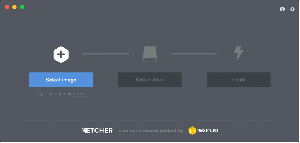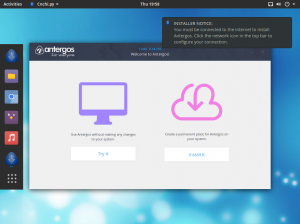In order to edit this wiki, you must register and verify your account.
Tutorial:Linux AMD MesaMild
Prerequisites
- An arch-based Linux distribution (for this guide we will use Antergos).
- An AMD GPU (Vega Series does not work for now, only RX and lower).
- About 60 GB of un-allocated disk space (having a dedicated disk is much easier but you can also dual-boot).
- A USB stick preferably
- Internet access. 8 GB in size.
- Time and Patience.
Preparation
Firstly we need to download our Linux distribution so lets go ahead to this site, scroll down, find the "Latest Install Media" tab and download the Antergos LIVE ISO either normally or by torrent.
As that downloads lets go ahead and download Etcher. We will use Etcher to make a bootable USB stick out of the ISO we downloaded.
Once Antergos has finished downloading insert your USB stick in your PC and run Etcher. Select the ISO you downloaded, select the USB stick and press "FLash" as seen in the image below.
Once that finishes we can go ahead and reboot our computer. What we need to do now is enter the BIOS and change our Boot Order. This process is different for each motherboard but generally you need to press Esc, Del or one of the F keys until you are given a list of boot drives. Select the USB stick you made and press Enter. A black screen will come up and you must choose the first option called "Antergos_x86_x64". Shortly this screen will popup.
If you have a dedicated hard drive you can use this guide. If you are dual-booting with windows you can use this guide to successfully install antergos. You can use "Disks" (Press the start key and search for disks) to create some space in a non-dedicated hard drive but be VERY careful as you can cause a lot of damage to your system if you do not know what you are doing. Generally create an EXT4 partition with / as the mount point (atleast 50-60 GB) and create an 8 GB Swap partition (with no mount point). If your RAM is larger than 8 GB the swap partition can be smaller. If you are dual-booting make sure to select your windows boot partition (its a fat32 partition about 130 Mb in size) choose edit and select "/boot/efi" as your mount point and make sure it is NOT being formatted.Lastly choose your username and password and choose save. The system will now install antergos, wait for it to finish. If you have trouble understanding any of this, STOP, go to discord and message me for help: pamehabai6#0001.
Mesa drivers and Mild Compatibility
After the installation has finished, reboot your computer, remove your USB disk and boot into your newly installed Linux system. Now open a terminal window and copy paste (use ctrl + shift + v) the following commands.
sudo pacman -Syyu
This command will install Git, Docker and the 32-bit GCC libraries which are missing:
sudo pacman -Sy git lib32-gcc-libs docker
Replace Username with the username you specified in installation. If you do not remember it open a terminal window and input "whoami" and press enter.
sudo usermod -aG docker Username sudo systemctl enable docker
At this point restart your computer, log into Antergos again and open the terminal.
git clone https://github.com/mikakev1/MildInstaller.git cd MildInstaller/
The following command will build the mesa drivers and mesa mild compatibility. This will take a long time to complete:
./kazhedctl build --radeon --vulkan --optimise=15
If you want to use Wine-staging instead of wine use the following command instead:
./kazhedctl build --radeon --vulkan --optimise=15 --experimental=wine
While the drivers are being built you can go ahead and copy your cemu games into your home folder using "Files" from the bar to the left part of the screen.
Once the build process has finished, open "Files", go into the folder "MildInstaller", then "Helpers" and double click the file called "Cemu.sh".
Find these lines:
| CEMU_VERSION=1.11.3 |
| CEMU_HOOK_VERSION=1113_0560 |
And change them to:
| CEMU_VERSION=1.11.4 |
| CEMU_HOOK_VERSION=1114_0563 |
Go back to the terminal and enter:
./kazhedctl install --cemu ./kazhedctl configure --cemu ./kazhedctl start --cemu
After a while a window will popup, choose install in all prompts and after some time Cemu should start. If it doesn't reboot your computer, open the terminal and enter:
- cd MildInstaller/
- ./kazhedctl start --cemu
If you have a previous cemu installation under windows and you want to copy over your saved games, open "Files" press "ctrl + H" and then navigate to your windows installation in "Other locations", find Cemu and copy "ShaderCache" and "mlc01" into home/.cemu_prefix/drive_c/cemu/cemu_latest/. You can also download the latest cemu graphic packs from here, unzip them and place them inside the "graphicPacks" folder. Also make sure your Cemu settings are as follows:
| Setting | Value |
|---|---|
| Upscale Filter | Bilinear |
| GPU Buffer cache Accuracy | Low |
| Experimental | Use RDTSC |
| Experimental | Full Sync at GX2DrawDone() |
| CPU Mode | Dual or Triple core recompiler |
Then load a game and you are good to go.
Experimental
These settings are only used if you are manually installing Mesa Mild Compatibility without Mild installer. I will cover the manual installation when i have some more time. After a system reboot, open the terminal and input:
sudo pacman -S winetricks driconf
Replace Username with your Linux username.
env WINEPREFIX="/home/Username/.cemu_prefix" winetricks vcrun2015 driconf
A window will pop up, choose Expert mode, make Cemu(Wine) is selected in the list on the left, and change the following entries:
| Menu | Setting | Value |
|---|---|---|
| Performance | Enable offloading GL driver work to a separate thread | Yes |
| Debugging | Force GLSL extention default behavior to 'warn' | Yes |
| Debugging | Allow a higher compat profile for apps that request it | Yes |
| Debugging | Force default GLSL version for shaders that lack an explicit #version line | 450* |
*CAUTION: This specific setting WILL break your Linux installation if you use it on the Default profile.

